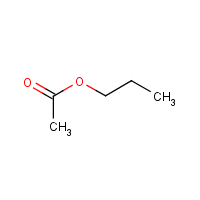n-Propyl acetate
Agent Name
n-Propyl acetate
CAS Number
109-60-4
Formula
C5-H10-O2
Major Category
Solvents

Synonyms
1-Acetoxypropane; 1-Propyl acetate; Acetate de propyle normal [French]; Acetic acid n-propyl ester; Acetic acid, propyl ester; Octan propylu [Polish]; Propyl acetate; Propyl ethanoate; Propylester kyseliny octove [Czech]; n-Propyl acetate; n-Propyl acetate (natural); n-Propyl ethanoate; [ChemIDplus] UN1276
Category
Esters (<C12)
Description
Colorless liquid with a mild, fruity odor; [NIOSH]
Sources/Uses
Used as a solvent, flavoring agent, and chemical intermediate; [ACGIH]
Comments
Esters may induce narcosis in animals, but workers' exposures are limited by irritating effects. See appendix in: [Dick RB, et al. Chemicals in the workplace: incorporating human neurobehavioral testing into the regulatory process. Am J Ind Med. 1998 May;33(5):439-53.] A skin, eye, and respiratory tract irritant; Inhalation of high concentrations can cause CNS depression; [ICSC]
Biomedical References
Exposure Assessment
Skin Designation (ACGIH)
Insufficient data
TLV (ACGIH)
100 ppm
STEL (ACGIH)
150 ppm
PEL (OSHA)
200 ppm
MAK
100 ppm
IDLH (NIOSH)
1700 ppm
Excerpts from Documentation for IDLHs
Basis for original (SCP) IDLH: The chosen IDLH is based on the statement by ACGIH [1971] that a 4hour exposure to 8,000 ppm was fatal to 4 of 6 rats [Smyth et al. 1954]. . . . Human data: None relevant for use in determining the revised IDLH.
Vapor Pressure
35.9 mm Hg
Odor Threshold Low
0.04 ppm
Odor Threshold High
0.7 ppm
Lethal Concentration
LCLo (rat) = 8,000 ppm/4H
Explanatory Notes
Detection odor threshold from AIHA (mean = 0.18 ppm); Flash point = 14 deg C; VP from HSDB;
NFPA
may ignite at ambient temp
Adverse Effects
Neurotoxin
Acute solvent syndrome
Diseases, Processes, and Activities Linked to This Agent
Diseases
Occupational diseases associated with exposure to this agent:
Processes
Industrial Processes with risk of exposure: